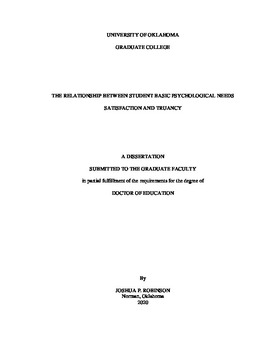| dc.contributor.advisor | Ford, Timothy | |
| dc.contributor.author | Robinson, Joshua | |
| dc.date.accessioned | 2020-03-30T13:57:11Z | |
| dc.date.available | 2020-03-30T13:57:11Z | |
| dc.date.issued | 2020 | |
| dc.identifier.uri | https://hdl.handle.net/11244/323821 | |
| dc.description.abstract | In spite of intense efforts to reduce student truancy, the prevalence of truancy at the high school level has remained consistent. The body of knowledge exploring truancy has identified myriad correlational relationships with truancy. The extant literature tends to focus on providing data to support how truancy is related to other abhorrent behaviors and undesirable life outcomes. However, little evidence has been presented with regard to the mechanisms underlying why students skip class. Many of these studies operationalize truancy as entire days of school missed without the knowledge or consent of their parents. Few studies have operationalized truancy to include individual sections of class skipped after a student has arrived to school. Few studies have examined truancy through the lens of Self-Determination Theory. The study of truancy through the lens of Self-Determination Theory may help to provide evidence for the mechanisms behind why students are motivated to attend class or not. The purpose of this study was to conduct an initial empirical investigation into the relationship between student perceptions of basic psychological need satisfaction or frustration and truancy. A randomly selected group of 10th, 11th, and 12th grade students from a large comprehensive urban high school participated in a school climate survey. Self-reported student perception data garnered from the climate survey and district administrative attendance data were utilized. Spearman’s rho correlational and negative binomial regression analyses were employed to determine the strength and direction of the relationship between student psychological needs and truancy. Results of the analysis indicated class truancy to be highly prevalent overall and across all measured student subgroup categories. While no significant associations were found between the focal variables and truancy, several interesting findings were presented. | en_US |
| dc.language | en_US | en_US |
| dc.rights | Attribution-NonCommercial-NoDerivatives 4.0 International | * |
| dc.rights.uri | https://creativecommons.org/licenses/by-nc-nd/4.0/ | * |
| dc.subject | Truancy | en_US |
| dc.subject | Self Determination Theory | en_US |
| dc.subject | Basic Psychological Needs | en_US |
| dc.title | THE RELATIONSHIP BETWEEN STUDENT BASIC PSYCHOLOGICAL NEEDS SATISFACTION AND TRUANCY | en_US |
| dc.contributor.committeeMember | Adams, Curt | |
| dc.contributor.committeeMember | Ballard, Keith | |
| dc.contributor.committeeMember | Edwards, Beverly | |
| dc.contributor.committeeMember | Grinnell-Davis, Claudette | |
| dc.date.manuscript | 2020-03 | |
| dc.thesis.degree | Ed.D. | en_US |
| ou.group | Jeannine Rainbolt College of Education::Department of Educational Leadership and Policy Studies | en_US |
| shareok.nativefileaccess | restricted | en_US |

